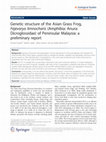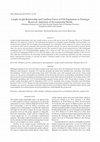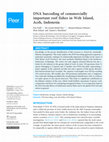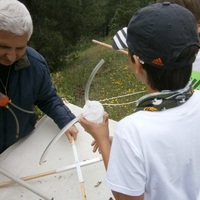Papers by SITI AZIZAH MOHD NOR

BackgroundFrequent monitoring of mosquito vector population is a strategy of great importance for... more BackgroundFrequent monitoring of mosquito vector population is a strategy of great importance for reducing risks of disease occurrence. In Sudan, malaria is still a big threat to public health. Insecticide-based control has been undertaken for years, but there is no noticeable decrease of malaria infection nationwide.ObjectiveTo overcome this situation, a better understanding of the breeding ecology of the vectors is relevant. Here, we investigate the species composition of malaria vectors, seasonal abundance and population structure in two different villages.MethodologyMonthly samplings were performed in Abu Algoni (Sennar State) and Algerif West (Khartoum State) from June 2010 to May 2011. During each visit, immature stages were collected from potential breeding sites using dipping technique. In addition, adults were collected indoors from houses by aspiration and indoor pyrethrum spray methods. Mosquitoes were identified morphologically, the Anopheles gambiae complex diagnosed us...
Available at Perpustakaan Sultan Abdul Samad, Universiti Putra Malaysia, 43400 UPM Serdang, Selan... more Available at Perpustakaan Sultan Abdul Samad, Universiti Putra Malaysia, 43400 UPM Serdang, Selangor, Malaysia. mal SH307 M3N277 2008 Call Number
FIGURE 1. Distribution of Lycodon cavernicolus sp. nov. and L. butleri in Peninsular Malaysia. St... more FIGURE 1. Distribution of Lycodon cavernicolus sp. nov. and L. butleri in Peninsular Malaysia. Stars designate type localities.

The purpose of this study was to evaluate the in vitro and in vivo antimicrobial activity of the ... more The purpose of this study was to evaluate the in vitro and in vivo antimicrobial activity of the commercial Lactobacillus acidophilus (L. acidophilus) cells and cell free extract against Aeromonas hydrophila (A. hydrophila). The in vitro method was carried out using well diffusion method. For in vivo evaluation, the effect of L. acidophilus on the survival rate of Pangasianodon hypophthalmus (P. hypophthalmus) infected with A. hydrophila was evaluated. The well diffusion method showed a significant inhibition ability of L. acidophilus cells against A. hydrophila compared to the cell free extract. The inhibition diameters obtained with cells and cell free extract were 17.23 mm and 15.17 mm, respectively. P. hypophthalmus injected with L. acidophilus cells and cell free extract following challenged with A. hydrophila cells showed survival rate of 70% and 60% respectively, at 2-week post challenged. The gas chromatography-mass spectrophotometry (GC-MS) result revealed that a diverse of...
FIGURE 4. Left: ventral pattern of the holotype of Lycodon cavernicolus sp. nov. LSUHC 9985. Righ... more FIGURE 4. Left: ventral pattern of the holotype of Lycodon cavernicolus sp. nov. LSUHC 9985. Right: ventral pattern of the paratype LSUHC 10500. Photos by L. L. Grismer
Aquaculture International
Mitochondrial DNA Part A
Abstract A total of 74 shrimp specimens were sequenced at a 584 bp segment of the cytochrome oxid... more Abstract A total of 74 shrimp specimens were sequenced at a 584 bp segment of the cytochrome oxidase subunit I (COI) gene to examine patterns of DNA barcode variation in a mangrove biodiversity hotspot. The Maximum Likelihood tree, barcode gap analysis, Automatic Barcode Gap Discovery analysis and sequence comparisons with data available from Barcode of Life Data System and GenBank recovered 18 taxa of which 15 were identified to species level, 2 at genus level and a single taxon at order level. Two deep mitochondrial DNA lineage divergences were found in the giant tiger prawn, Penaeus monodon. It is suggested that one of the lineages is a consequence of an introduction from aquaculture activity. These results have provided a reliable barcode library for cataloguing shrimps in this area.

Fisheries Science
The effects of galactooligosaccharide (GOS) and a combination of yeast and β-glucan (YβG) supplem... more The effects of galactooligosaccharide (GOS) and a combination of yeast and β-glucan (YβG) supplementation of dietary soybean meal (SBM) on the growth and digestive performance of striped catfish Pangasianodon hypophthalmus were evaluated. Four isonitrogenous (30% protein) and isocaloric (19 MJ/kg diet) diets were formulated to contain 100% fish meal (FM) protein, 55% FM protein/45% SBM protein, FM-SBM supplemented with 1% GOS, and a combination of 1% yeast and 0.1% β-glucan, respectively. Each diet was fed for 12 weeks to three groups of 30 striped catfish fingerlings (average weight 16.45 ± 0.07 g) maintained in circular fiberglass tanks (600 l). Growth, feed utilization, and muscle protein composition of fish improved significantly after supplementation with either GOS or YβG compared to the unsupplemented SBM diet, but were similar to those of fish fed the FM diet. Nutrient digestibility, digestive enzyme activities, villi and microvilli length were significantly increased in fish fed the supplemented SBM diets. The gut microbiota ranking profile showed that supplementing the SBM diet with YβG and GOS gave a ranking of Verrucomicrobia, Spirochaetes, Bacteriodetes, and Actinobacteria phyla similar to that of the FM diet. Thus, diet containing 45% protein from soybean supplemented with either GOS or YβG can be recommended to improve the growth and digestive performance of striped catfish.
CHIRONOMUS Journal of Chironomidae Research, 2006

Zoological Studies, 2014
Background: Fejevarya limnocharis (Dicroglossidae) is found widespread in Peninsular Malaysia. We... more Background: Fejevarya limnocharis (Dicroglossidae) is found widespread in Peninsular Malaysia. We analyzed the mitochondrial DNA control region sequence data to evaluate the genetic variability and population structure of this species, based on 106 individuals from 14 populations in the west coast (northwest and central west) and two populations from the east coast of Peninsular Malaysia. Results: Of 519, 13 variable sites (six parsimony informative sites) were observed, defining 14 unique haplotypes. We found very low levels of genetic variability, with three of the 16 populations exhibiting total absence of genetic variation. Both phylogenetic analyses based on NJ and MP methods failed to detect any geographic structuring between the east and west coast (northwest and central west combined) populations. Conclusions: Consequently, it can be inferred that genetic structuring F. limnocharis populations in the Peninsular Malaysia was largely shaped by natural barriers. However, when this breaks down as between the central west and east peninsular regions, genetic differentiation is reduced. Further studies, with more efficient markers and larger populations, especially from the southern regions, are required to corroborate the findings.

Length-weight relationship (LWR) and condition factor of seven fish species from the Temengor Res... more Length-weight relationship (LWR) and condition factor of seven fish species from the Temengor Reservoir, Peninsular Malaysia were analyzed. A total of 1155 individuals belonging to two families namely Nandidae and Cyprinidae were measured and weighed. The most highly represented family was Cyprinidae which comprised six species. Among these seven species, three species generally showed positive allometric growth, two species showed isometric growth and the other two species showed negative allometric growth. The exponent b value of LWR ranged between 2.601 (Oxygaster anomalura) and 3.157 (Cyclocheilichthys apogon) with a mean of 2.983. The lowest mean condition factor, K was recorded in O. anomalura (0.648 ± 0.131) while the highest value was observed in Pristolepis fasciata (2.194 ± 0.153). This study has contributed to the knowledge of fish populations in this economically important area that could assist fishery management scientists in carrying out future ecological studies in l...
Comparative Biochemistry and Physiology Part C: Toxicology & Pharmacology

ARPHA Conference Abstracts
Freshwater species are the most threatened group to be assessed to date by the IUCN. Freshwater f... more Freshwater species are the most threatened group to be assessed to date by the IUCN. Freshwater fish has enormous importance as animal protein supplies for human, and it is estimated that 6% of the world annual animal protein supplies come from freshwater fishes. Barcoding projects have been initiated all over the world and the field is constantly growing. In Malaysia however, the field has not been deeply investigated and not many barcoding projects have been undertaken especially for freshwater fishes. The aim of our study is to support the progress of DNA barcode project, especially for inland reservoirs like Tasik Raban, Perak. A Standard methodology using Cytochrome c oxidase subunit 1 (COI) marker was developed to ensure native fishes are barcoded taxonomically and molecularly and ready to be accessed through online databases. Such public references can help increase awareness on local fish diversity management. Information on taxonomy and molecular characterization can be use...

PeerJ
Knowledge on the precise identification of fish resources is critical for sustainable fisheries m... more Knowledge on the precise identification of fish resources is critical for sustainable fisheries management. This study employs the DNA barcoding approach to generate a molecular taxonomic catalogue of commercially important reef fishes in the waters of Weh Island (Aceh Province), the most northerly inhabited island in the biodiverse Indonesian Archipelago. The waters not only support artisanal fisheries but also a feeder for the industry in the greater island of Aceh. In total, 230 specimens from 72 species belonging to 32 genera and 17 families were DNA barcoded, representing a major segment of the captured reef fish taxa and a quarter of fish species diversity that had previously been recorded. The sequence read lengths were 639 bp revealing 359 conserved sites, 280 variable sites, 269 parsimony informative and 11 singletons. Our molecular findings paralleled the morphological identification with no evidence of cryptic species or new species discovery. This study is a significant ...

PeerJ
The population genetic diversity and demographic history of the longtail tuna Thunnus tonggol in ... more The population genetic diversity and demographic history of the longtail tuna Thunnus tonggol in Malaysian waters was investigated using mitochondrial DNA D-loop and NADH dehydrogenase subunit 5 (ND5). A total of 203 (D-loop) and 208 (ND5) individuals of T. tonggol were sampled from 11 localities around the Malaysian coastal waters. Low genetic differentiation between populations was found, possibly due to the past demographic history, dispersal potential during egg and larval stages, seasonal migration in adults, and lack of geographical barriers. The gene trees, constructed based on the maximum likelihood method, revealed a single panmictic population with unsupported internal clades, indicating an absence of structure among the populations studied. Analysis on population pairwise comparison ФST suggested the absence of limited gene flow among study sites. Taken all together, high haplotype diversity (D-loop = 0.989–1.000; ND5 = 0.848–0.965), coupled with a low level of nucleotide...










Uploads
Papers by SITI AZIZAH MOHD NOR